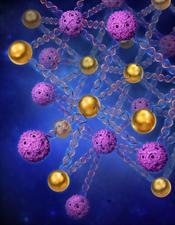Scientists have succeeded in producing a diamond-like network consisting of gold nanoparticles and virus particles interwoven and held together by DNA coils. The innovative structure - a defined mixture of metallic and hard nanoparticles together with parts of viruses (capsids), bound together by the molecule of life - DNA - is a fascinating step in the scientists' ability to combine a variety of materials to make extremely tiny devices.

The findings of the study, conducted by scientists from the University of Rochester Medical Center (Rochester), the Scripps Research Center (Scripps) and the Massachusetts Institute of Technology (MIT), were recently published in the scientific journal Nature Materials.
Although people usually think of DNA as a prescription for life, the research team used DNA, instead, as a means of precisely directing tiny particles while the DNA helices act as companions to the particles.
A key feature of the research is the unique and selective affinity of the four chemical bases of DNA to each other. The researchers prepared specific segments of DNA and then attached them to gold nanoparticles and virus particles, thereby being able to precisely orient them and force them to organize themselves into a crystalline lattice structure.
When the researchers mixed the particles together, the crystalline lattice appeared spontaneously - the device simply "organized itself" or, in other words, built itself. In doing so, the researchers were able to provide additional flexibility to the collection of tools that scientists use to produce nanometer devices.
"Organic materials react in completely different ways than metallic nanoparticles. The fact that we were able to combine such different materials so that they fit into a common structure demonstrates several new possibilities for the preparation of nanoscale devices," explains Sung Yong Park, professor of biostatistics and computational biology at the University of Rochester.
Such a crystalline lattice is a key component in devices known as photonic crystals (the term in Wikipedia), Able to precisely control light radiation and block certain colors/wavelengths from passing through the lattice. Although XNUMXD photonic crystals already exist that are able to "bend" radiation at higher wavelengths, such as infrared radiation, the new crystal is able to control visible light radiation. Scientists around the world envision many applications for this type of crystal, ranging from optical computers to telecommunications systems, but manufacturability and degree of stability still pose serious challenges in this field.
Inside the structure, two distinct forces act, the researcher points out - the gold particles and the virus particles repel each other, but this repulsion is canceled out by the attraction between the complementary DNA helices that are precisely placed.

4 תגובות
Sick of the 21st century…….Really Star Trek comes true for me in front of the poor
I'm sure my children's children will enjoy it
This will be medical technology for the rich only for at least the first ten years after nanobiological treatments are developed.
There is no doubt that nanotechnology is the future of science, almost everything will come from it in the future, just like the electricity found in everything, if only you look for it!
As I already thought from previous letters and here it is already tangible, the spare parts that will be integrated into the body will come from the direction of the tiny nano and not as previously thought as large ready-made parts... In short, man is a machine much closer than it seems, although the parts of the "machine" will be tiny and will be integrated without standing out in the human body ..like small laboratories that will be placed in the body and transmit important "face" information out via nano transmitters, medicines that are released as needed are already familiar, small cleaners will definitely be a hit, improving hearing and vision, physical fitness, and more
And a tiny phone planted in the ear and, if anything, also an MP for listening to music directly in the brain!
MRTK!